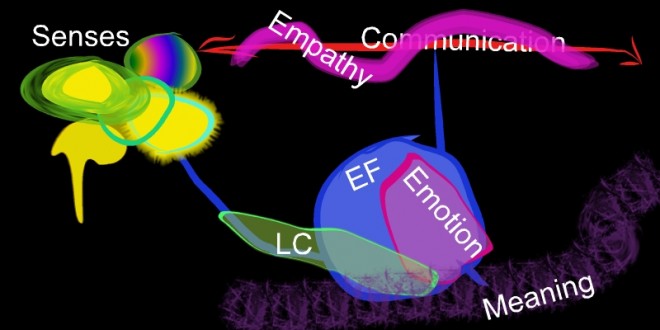This section is titled Insights because I believe that more traditional terms such as "findings", "data" or "discussion" are inadequate, and overly formal for this purpose. Much of the material presented here has come from the sudden understandings and penetrating flashes of clarity that occur with little warning and sometimes from surprising sources. In some cases they are the result of careful analysis of the collected data, in others they have resulted from the web based writing process, but in all cases they are "understanding" rather than "facts" or "truths".
The section has been organised around a set of cognitive traits, a subset of the autistic profile, that allows the effects of various perception, cognition, processing and emotional aspects to be clearly linked to my musical and creative activities. While these traits have been briefly described in the Context section, this is the opportunity to more actively explore their meanings, effects and practical implications. The diagram below is an attempt to show graphically my own understanding of the relationships as they relate to my own functioning. The exact nature of interaction and relationships is somewhat more complex and disputed, but the diagram provides a kind of road map for this section and each element is explored in its own "chapter".
Executive Function is shown as the mixing pot, the collector of information and the maker of Meaning. Executive Function, as the term would suggest, has a fundamental role in organising and interpreting incoming "data" and building meaning. The chapter includes Theory of Mind, that ability to spontaneously put oneself in the shoes of another.
The Senses are shown as being somewhat misshapen and distorted. The chapter on Sensory Issues explores unusual perceptions of my environment, distortions and overload of sensory input and the way these manifest in my music.
Local Coherence is shown as something of a filter for the Senses and acting upon the domain of the Executive Function. The balance of Local and Global Coherence can impact upon the way in which data is processed and may distort "reality" or result in atypical understanding or reactions. The autistic balance is towards a stronger Local Coherence, resulting in a preference and aptitude for detail or "parts of things"1 and sometimes difficulty with Gestalt or the "big picture"
Emotion is similarly impacting on Communication and Executive Functions.
Communication, flowing in two directions, is disrupted by the influence of rather patchy Empathy.
Communication covers specific deficits in collaborative activities, the ways that I get around weakness of non-verbal communication in the studio and elsewhere, and role that talking about the music plays in my practice.
Communication is interdependent with Empathy, and this raises a number of observations around the transmission of musical and technical ideas, and the distribution of power and management of ego within the studio and other collaborative moments.
Perhaps the most intriguing aspect of the Insights attained has been in the area of Emotion recognition and regulation. My music practice is strongly impacted by unusual traits in this area.
The final chapter in this section brings the various aspects together under the banner of Meaning-Making and discusses the ways in which some of the atypical aspects discussed are moderated or alleviated through conscious processes.
- including sounds, sentences and ideas [↩]
Related Posts
- The Heart of the Brain: The internal brain structures and pathways appear to have an impact on several aspects of autism, including executive function, the over-riding regulatory mechanisms for cognition and behaviour.
- Music for the Mind: Music has long been known to improve some aspects of functioning over time.
- Context: "Experience ... derives its validity from the conditions and context of consciousness in which it arises"
- What is ASD?: A brief overview of the Autistic Spectrum and the traits associated with it.
- Local Coherence: Local coherence is the focus on parts of objects or ideas rather than the Gestalt
- Thematic Analysis: Thematic analysis underpins the process of drawing insight from the narrative and media based data.
- The Safer Intimacy: Some forms of intimate communication are "safer" than others and facilitate a greater degree of emotional freedom.
